 Most people in Valdez know Andrew Goldstein as the Curator of Collections and Exhibitions for the Valdez Museum and Historical Archive. He’s also turned up in a couple of historical documentaries, including the recent one about the 1964 earthquake and tsunami on The National Geographic Channel. But you may not be familiar with Andrew’s art. He has participated in both group and solo exhibits in coffee shops and galleries in the Boston area and in Connecticut. Andrew has also done commissioned illustrations for some regional, independent-press magazines and a corporate annual report. But, other than a group show with the Northwoods Book Arts Guild in Fairbanks, a group promoting book art (http://nwbookarts.org/ ), all that’s been seen publicly in Alaska is the logo he did one year for Valdez Gold Rush Days.
Most people in Valdez know Andrew Goldstein as the Curator of Collections and Exhibitions for the Valdez Museum and Historical Archive. He’s also turned up in a couple of historical documentaries, including the recent one about the 1964 earthquake and tsunami on The National Geographic Channel. But you may not be familiar with Andrew’s art. He has participated in both group and solo exhibits in coffee shops and galleries in the Boston area and in Connecticut. Andrew has also done commissioned illustrations for some regional, independent-press magazines and a corporate annual report. But, other than a group show with the Northwoods Book Arts Guild in Fairbanks, a group promoting book art (http://nwbookarts.org/ ), all that’s been seen publicly in Alaska is the logo he did one year for Valdez Gold Rush Days.
After many years Andrew is beginning to produce new artwork. He says he hopes to build up his portfolio and expects that the next few years will provide him with that opportunity. He works with a wide variety of styles and subjects from story illustrations to portraits and fantastic landscapes. He says art has been a lifelong passion and considered a career in illustration when he was in high school.
“After so many years, rediscovering my artistic side has been like getting back in touch with an old friend.”
His favorite medium is oil paints. Oils aren’t practical when working in small spaces or on a deadline though, because of the length of time that it takes for them to dry. So most of the time he works in gouache or some combination of gouache, watercolor and colored pencils. Gouache is an opaque watercolor paint. Unlike watercolors, which are transparent, gouache does not allow you to see the white paper under the paint. It can be applied in solid colors like oils or acrylics and layered from dark to light. It is similar to watercolor because it can be re-wet and because the paint melds with the canvas or paper, rather than forming a layer on top of it as acrylic or oil paint do. Also like watercolor, gouache dries to a matte finish.
|
|
Gouache has a considerable history. In ancient Egypt, the binding of pigments with honey or tragacanth glue created a form of gouache, and by the Middle Ages, it appeared on illuminated manuscripts. In the late fourteen hundreds and early fifteen hundreds, it was used to achieve a deep finish and a soft glow. In 18th-century Europe, gouache became popular with artists seeking its pearly, pastel tones. The experimentation with different chemical compounds that resulted in the development and improvement of gouache-style paints is a good illustration of the connection between art and science.
Andrew received a Bachelor of Fine Arts in Illustration from the Rhode Island School of Design and a Master of Arts in American Studies from Trinity College in Hartford Connecticut. He has taught Intro to Narrative Illustration at Prince William Sound College. Andrew and his family have lived in Valdez for ten years.

